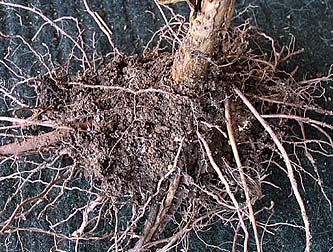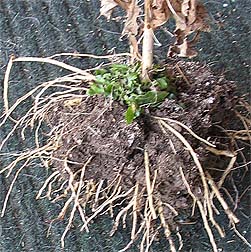
Verbesina virginica
|

Pluchea odorata
|
| January 26, 2008
|
Roots & Shoots of Crystallofolia Plants in Central Texas
by Bob Harms (

)
19th Century botanists focused attention primarily on the beauty of the formations, and, to a lesser extent, on the anatomy of the stem. But they provide no clear picture of the role of roots, or just how moisture is transferred to the point of ice formation on the stem. It is interesting to note some of their statements and reasoning:
- Sir John Herschel 1833
- ... the only quarter to which we can look for their origin is in the plant itself, or in the comparatively warm earth beneath, to whose exhalations the decaying stems may form a kind of chimney.
- William Darlington 1837
- moisture from the earth rising in the dead stems by capillary attraction
- John Le Conte 1850
- We must, therefore, look to the moist earth for the large supply of water necessary for the development of these voluminous masses of ice. [p. 24]
... it is probable that all vital action mush have ceased in order that the fluid which is elevated from the soil may be unmixed with the proper juices of the plants; a mixture which would interfere with congelation.[p. 33]
- Jacob Stauffer 1877
- I took up a number of the plants, and always found a vigorous scaly root bud, undergoing development at this early season under ground, to produce a new stem the following spring...the expanding bud, in close proximity to the surface, gave out sufficient caloric or warmth to generate vapor from the moist soil.
- Daniel T. MacDougal 1893
- Then root pressure must be wanting as well as osmotic activity in plants at this stage.
And Stauffer alone seems to have actually inspected a root!
‘Checking under the Hood’ : A New View of the Role of the Roots
When after numerous eruptions of crystallofolia, with the formations at the very base of the stem, upon close inspection I noticed that new shoots, even leaves, were already emerging — a clear indication of a robust, active root. So I extracted typical specimens of each species, cleaned the roots, and photographed the shoots and leaves, especially the enlarged area at the stem–root juncture. I was impressed with the size and succulence of the roots. The soil was neither dry nor very moist — not an obvious source of immediate water. My overall impression is that the xylem sap within the plant alone (stem plus roots) is sufficient to account for ice crystals that formed, and that the roots are capable of producing sufficient pressure to make a significant contribution once the epidermal/cortex freezing has been minimized. Collecting a chunk of the ice demonstrated that upon melting only a few drops of water resulted — the crystallofolia contain a lot of air. This is not to say that the water drawn up from the roots was not quickly replaced from the soil, but there is little evidence that the phenomenon supports a direct soil–to–ice water transport system.
William Coblentz 1914 (p. 494) weighed the ice on relatively large formations with Cunila origanoides:
On January 7 the ice fringes formed on a single plant were collected and weighed. The ice formation on this plant on this date weighed over 5 grams. The weight of the ice on the large sample shown in the photographs, figures 15-19, is probably between 4 and 5 grams.
My root pictures, taken Jan. 26, 2008, are given in large thumbnails on this page. Click for an enlarged or expanded view.
V. virginica — January 26, 2008
P. odorata — January 26, 2008